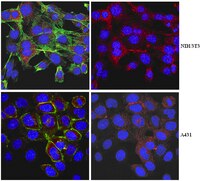Absence of platelet phenotype in mice lacking the motor protein myosin Va.
Harper, MT; van den Bosch, MT; Hers, I; Poole, AW
PloS one
8
e53239
2013
概要を表示する
The motor protein myosin Va plays an important role in the trafficking of intracellular vesicles. Mutation of the Myo5a gene causes Griscelli syndrome type 1 in humans and the dilute phenotype in mice, which are both characterised by pigment dilution and neurological defects as a result of impaired vesicle transport in melanocytes and neuroendocrine cells. The role of myosin Va in platelets is currently unknown. Rab27 has been shown to be associated with myosin Va cargo vesicles and is known to be important in platelet dense granule biogenesis and secretion, a crucial event in thrombus formation. Therefore, we hypothesised that myosin Va may regulate granule secretion or formation in platelets.Platelet function was studied in vitro using a novel Myo5a gene deletion mouse model. Myo5a(-/-) platelets were devoid of myosin Va, as determined by immunoblotting, and exhibited normal expression of surface markers. We assessed dense granule, α-granule and lysosomal secretion, integrin α(IIb)β(3) activation, Ca(2+) signalling, and spreading on fibrinogen in response to collagen-related peptide or the PAR4 agonist, AYPGKF in washed mouse platelets lacking myosin Va or wild-type platelets. Surprisingly, Myo5a(-/-) platelets showed no significant functional defects in these responses, or in the numbers of dense and α-granules expressed.Despite the importance of myosin Va in vesicle transport in other cells, our data demonstrate this motor protein has no non-redundant role in the secretion of dense and α-granules or other functional responses in platelets. | 23349704
 |









